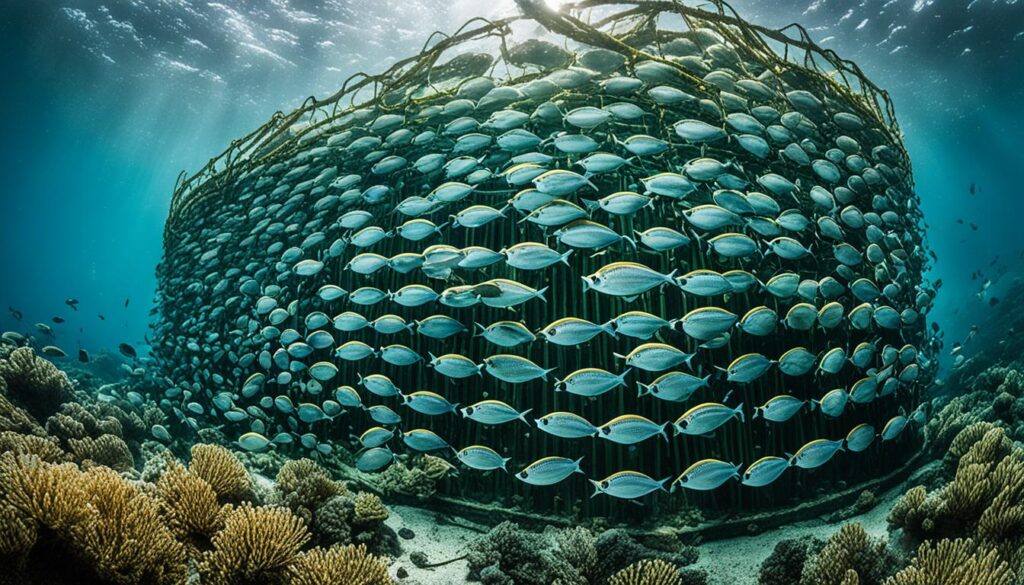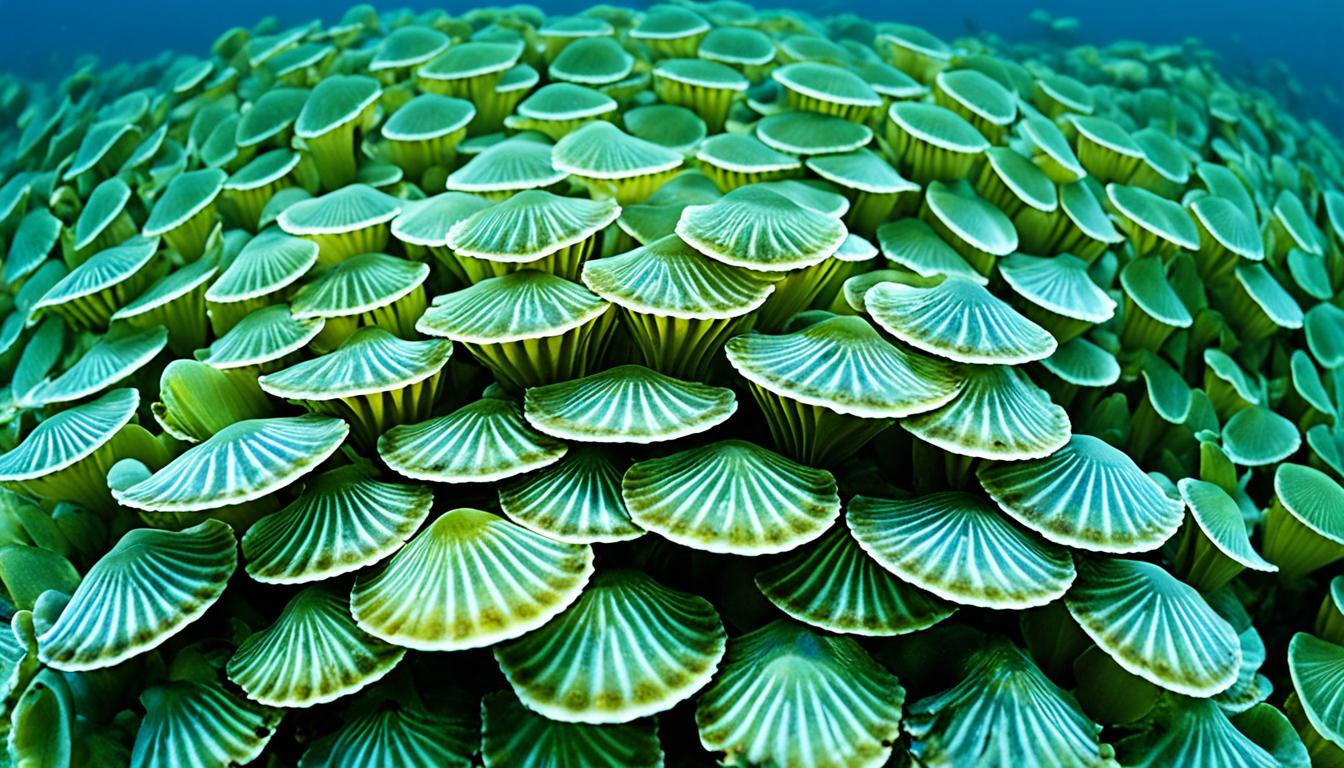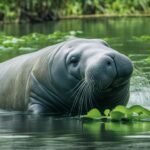Have you ever thought about how scallops affect marine ecosystems? These creatures, especially the Atlantic sea scallop, are key to keeping our oceans healthy. They help keep the water clear by eating a lot of phytoplankton. This supports the food web and affects the variety of life in the sea.
Scallops also change the environment with their behavior and numbers. Studies show they play a big part in recycling nutrients, keeping sediment healthy, and shaping the sea floor. Knowing their role helps us understand the complex balance of marine life.
Understanding the Role of Scallops in Marine Food Webs
Scallops are key players in marine ecosystems. They help keep the water clean by eating phytoplankton. This balance is crucial for a healthy ocean.
Let’s see how scallops affect phytoplankton and their role in the food web.
Scallops as Filter Feeders
Scallops eat by filtering the water for food. They remove excess phytoplankton, making the water clearer. This keeps the ocean healthy.
By eating phytoplankton, scallops control their numbers. This stops harmful algae from growing too much.
Impact on Phytoplankton Populations
Scallops have a big effect on phytoplankton. These tiny plants are the base of the ocean’s food web. Scallops help keep their numbers in check.
This grazing helps maintain a balanced ecosystem. It’s important for a healthy ocean.
Scallops and Predator-Prey Relationships
Scallops also play a big role in the food web. They affect the numbers of sea stars and fish that eat them. This changes the balance of the ocean’s food chain.
Scallops help both predators and herbivores. They keep the food web in balance.
How do scallops impact marine ecosystems?
Scallops are key to keeping marine ecosystems healthy and balanced. They help with nutrient cycling and support many benthic communities through their biological processes, especially biodeposition.
Biodeposition and Nutrient Cycling
Scallops release feces and pseudofeces, which add organic material to the ocean floor. This material brings nutrients back into the ecosystem. It helps create a good environment for many organisms to grow.
Good nutrient cycling is vital for clean water and healthy marine habitats. Scallops make nutrients more available, helping other sea life thrive.
Effects on Benthic Communities
Scallops also affect benthic communities. They change the sediment, which helps other filter feeders and infaunal species grow. Studies show scallops can change the makeup of these habitats.
This change leads to more diverse and thriving communities. It helps many marine species. Scallops start a chain of events that increases marine biodiversity.
| Process | Impact | Importance |
|---|---|---|
| Biodeposition | Enriches sediment | Enhances nutrient cycling |
| Alteration of sediment | Supports filter feeders | Increases diversity |
| Community shaping | Creates favorable habitats | Boosts marine biodiversity |
Scallop Populations Effect on Marine Environments
Scallops play a big role in marine life. Their numbers can change the balance of life in the ocean. When there are more scallops, it can change who lives where and how many there are. They eat a lot, which can push other sea creatures out.
Changes in Biodiversity and Species Composition
When scallops are more common, it changes the ocean’s balance. This leads to:
- Dominance of specific species in benthic communities
- Reduction in habitats available for other marine organisms
- Disruption of nutritional dynamics within food webs
This shift affects not just local sea life but also the whole ecosystem. It changes the food chain at different levels.
Invasive Species and Disease Transmission
Bringing in scallops from other places can spread invasive species and diseases. This is a big problem:
- Invasive species may take over from native scallops, reducing their numbers.
- Diseases can spread to both wild and farmed scallops.
- Changes in who eats who can upset the balance in the ocean.
We need to understand how scallops affect the ocean to manage it better. We can work on strategies to keep the ocean healthy for all life.
| Impact Factor | Effect on Biodiversity | Example |
|---|---|---|
| Scallop Overpopulation | Decrease in Species Variety | Native mussels decline due to competition |
| Invasive Species Introduction | Loss of Native Species | Non-native oysters outcompete local scallops |
| Disease Outbreaks | Population Decline | Mass mortality of both wild and farmed scallops |
Environmental Impact of Scallop Farming
Scallop farming has many benefits but also big environmental challenges. It’s important to understand these impacts for sustainable farming. The main issues are habitat destruction and pollution from feed and chemicals.
Habitat Destruction and Alteration
Large-scale scallop farms can destroy habitats. Nets and cages harm the seafloor, affecting many marine creatures. This harms biodiversity and upsets local ecosystems.
This makes it hard for marine life to survive. It disrupts the balance of the ocean.
Pollution from Feed and Chemicals
Feed and chemicals in scallop farming pollute the water. This can cause big problems. Nutrient overload leads to harmful algal blooms, which use up oxygen and create dead zones.
Chemicals for disease control make things worse. They hurt marine health. We need to fix this pollution to protect the ocean.

| Impact Area | Details | Consequences |
|---|---|---|
| Habitat Destruction | Disruption from structures like nets and cages | Loss of biodiversity and marine habitats |
| Water Pollution | Excess nutrients from feed | Harmful algal blooms, oxygen depletion |
| Chemical Use | Fertilizers and disease control products | Negative impacts on marine organisms |
Sustainable Scallop Harvesting Practices
It’s crucial to use sustainable scallop harvesting to keep marine ecosystems healthy. These methods focus on balancing scallop harvesting with protecting the environment. They include monitoring scallop stocks and setting quotas to avoid overfishing. Also, using techniques that don’t harm the environment helps keep marine habitats safe.
Keeping marine ecosystems safe through scallop management is key for biodiversity. Good practices make marine habitats more resilient. This leads to more species diversity and a stable ecosystem. It’s important to control fishing methods that can harm underwater environments.
Supporting scallop farming and ecosystem health helps aquatic environments. Using natural food sources like phytoplankton in aquaculture makes ecosystems healthier. It also reduces the need for artificial feeds. By joining in, you help your local economy and marine conservation efforts.
Future Challenges and Research Directions
Marine ecosystems are changing fast, bringing new challenges for scallops and their homes. We need to understand these challenges well. This will help us find new ways to keep marine life strong.
Climate Change Impacts on Scallops
Climate change is affecting scallops in big ways. They’re facing changes in growth, breeding, and numbers. Rising sea temperatures and changing salt levels stress scallops out, threatening their future.
By studying these effects, we can make plans to help scallops. This will help protect them for the long run.
Integrative Approaches to Ecosystem Management
We need new ways to manage marine ecosystems. It’s important to use science and local knowledge together. This mix helps create plans that work for scallops.
Working together is key. People like policymakers, scientists, and fishermen must join forces. This teamwork helps make sure marine life stays healthy and strong.
Conclusion: The Importance of Scallops in Marine Ecosystems
Scallops are key to keeping marine ecosystems healthy and lively. They act as filter feeders, which helps with nutrient cycling for many marine creatures. By controlling phytoplankton, scallops keep the marine food web in balance. This shows how vital scallops are to the ocean’s health.
It’s important to understand scallops’ role in nature to protect them. We need to harvest and farm scallops in a way that’s good for the environment. We should all be aware of how our actions affect scallop populations and the ocean.
Spreading the word about scallops’ roles in nature helps us care more about the sea. Keeping scallop fisheries sustainable helps marine life and people who live by the sea. In short, your support for scallop conservation is key to keeping our oceans healthy.
FAQ
How do scallops impact marine ecosystems?
What is the ecological significance of scallops in oceans?
How do scallops contribute to marine biodiversity?
What effects do scallop populations have on marine environments?
What is the environmental impact of scallop farming?
What are sustainable scallop harvesting practices?
What are the future challenges facing scallops and their ecosystems?
Source Links
- https://www.int-res.com/articles/meps2016/547/m547p121.pdf
- https://www.fisheries.noaa.gov/feature-story/new-study-finds-ocean-acidification-and-warming-hinder-juvenile-atlantic-sea-scallop
- https://globalseafoods.com/blogs/news/the-environmental-impact-of-live-scallop-farming-what-you-need-to-know?srsltid=AfmBOoq10DNCPQbdxbcim5TmXJZs5YxvPT4BDk2racBt49WtQZ61sYQu










